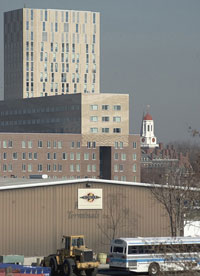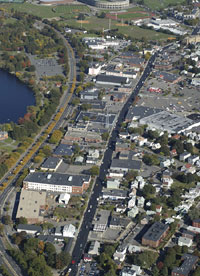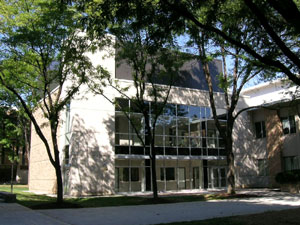UNIVERSITIES AND ECONOMIC DEVELOPMENT
Points of Enlightenment
Assistant Sec. DeRocco had an opportunity to witness the level of university partnerships firsthand in her team's recent review of 97 eligible applications for $15-million Workforce Innovation in Regional Economic Development (WIRED) grants. Thirteen winners were selected, and another 13 from that pool are on the short list for bonus points toward the next round. "It's like auditing a class," she says of those regions, "which we hope will set them on their way toward realization of their vision."
But in this case the academic plank is more than a metaphor.
"Universities came in fairly strongly in the applications," she said of the winning regions. "We have applications where the university was the chief sponsor – Purdue comes immediately to mind, and clearly stood out in putting together the proposal. In all of our proposals, colleges and universities are partners – it is a growing leadership role."
Here are a few glances at leaders in the field, in the form of both programs and projects:
PROJECTS
• On December 15, 2005, Google, Microsoft and Sun Microsystems announced they would team with researchers at the University of California, Berkeley, to launch a new Internet research laboratory called the Reliable, Adaptive and Distributed systems laboratory, or RAD Lab. The campus facility will be funded by $7.5 million over five years from the companies. "Our goal is to create technology that will enable individual inventors and entrepreneurs to provide new services of value similar to large Internet services people use every day," said David Patterson, UC Berkeley professor of electrical engineering and computer sciences and founding director of the RAD Lab. "The companies benefit by witnessing ideas in pre-competitive technologies at the early stages of development, and they will help point out the real-world obstacles that must be overcome." Staffed by six faculty and 10 grad students initially, the lab is expected to get 80 percent of its funding from private industry. On the same exact day as the Berkeley lab announcement, Sunnyvale-based Yahoo announced it would establish a research center in New York, in close proximity to Columbia University.
• In association with multiple expansions totaling $110 million in investment by pharmaceutical firm Hospira in the city of McPherson, the Kansas Bioscience Authority will partner with Hospira to create a scholars program at the plant. KBA will provide scholarships to help support science internships at the facility for students who attend Kansas Regents universities. Additionally, the KBA will offer signing bonuses and student loan reduction packages for recent graduates of Kansas higher-education science programs who commit to a minimum of two years of full-time employment at the McPherson facility.
• In April 2006, the Hagerstown-Washington County Economic Development Commission in Maryland began an out-commuter work force study in concert with RESI, a research and consulting firm associated with Towson University. Founded in 1989 and formerly known as the Regional Economic Studies Institute, RESI moved to Towson in 1996. In 16 years RESI has become a recognized state and regional authority in the fields of applied economics, human services forecasting and policy analysis, organizational planning and technology solutions.
• Georgia Tech is recognized as a leader in economic development through such programs as its Economic Development Institute. And a quasi-campus of economic development has taken shape in a newly developing area of Atlanta's Midtown, home to state and utility economic development agencies and to such programs as the Georgia Electronic Design Center, which recently welcomed stand-alone research labs from Pirelli Labs and from Samsung Electro-Mechanics. Among the university's latest outreach efforts is the establishment of an applied research institute in Ireland by the Georgia Tech Research Institute, GTRI's first facility outside the U.S. The institute has the full backing of IDA Ireland, and will locate at the IDA Business and Technology Park in Athlone, County Westmeath.
 |
| Harvard's expansion and community revitalization activity at its Allston, Mass., campus illustrates the mandate that many urban universities face to combine programmatic expansion with improvement of their immediate physical surroundings. Photo: Peter Vanderwarker |
 |
• On December 8, 2005, the Semiconductor Industry Association announced it would establish two nanoelectronics research institutes at the State University of New York-Albany and at the University of California-Los Angeles. The Western Institute of Nanoelectronics (WIN) in California will include participants from UCal campuses at Berkeley and Santa Barbara, as well as from Stanford University. Some funding will come from Intel. The Institute for Nanoelectronics Discovery and Exploration (INDEX) in Albany will be headquartered at the College of Nanoscale Science and Engineering and will also include resources from Georgia Institute of Technology, Harvard University, the Massachusetts Institute of Technology, Purdue University, Rensselaer Polytechnic Institute and Yale University. New York Gov. George Pataki is requesting $80 million from the state legislature to construct a 250,000-sq.-ft. (23,225-sq.-m.) research facility for INDEX.
• In September 2005, St. Louis-based pharmacy benefit plan management company Express Scripts announced its intention to build a new $34-million corporate headquarters on the campus of the University of Missouri-St. Louis (UMSL). Express Scripts' new home will be built on a parcel of UMSL land. Adjacent to the HQ, University Place/NorthPark, a University of Missouri-St. Louis Business, Technology and Research Park is taking shape on 600 acres (243 hectares) the City of St. Louis began acquiring from Lambert International Airport in the 1980s in order to fulfill noise abatement obligations. In his annual State of the University address, delivered on the same day as the project announcement, UMSL Chancellor Thomas F. George had a lot more than the start of a new academic year to smile about: "Express Scripts is the type of company we had in mind when we began developing UMSL's business, technology and research park," George said. "It's a growing company whose operational needs, vision and values meld with UMSL's academic strengths and diverse connections to the region. Companies such as Express Scripts that locate in the business park will bring internship and job opportunities to our students, and potential research opportunities to our faculty. The communities, including the Normandy School District, will benefit from increased property tax income and other taxes generated by business-park employees as they begin to buy homes in nearby neighborhoods and patronize local retailers and restaurants."
• On March 13, 2006, the U.S. General Services Administration, in partnership with NOAA and Opus East, L.L.C., broke ground for the NOAA Center for Weather and Climate Prediction, the "crown jewel" in a new 50-acre (20-hectare) section of the University of Maryland's M-Square Research and Technology Park. The 268,762 sq.-ft. (24,968-sq.-m.) office and research complex will become the new home for NOAA's Satellite and Information Service, Air Resources Laboratory and the National Centers for Environmental Prediction, an office of the National Weather Service. Approximately 800 people will work in the facility. "Our goal is to create synergy with the research and academic community that will accelerate new science and technology into operations, improve forecast performance and result in better service to the American public," said retired Navy Vice Admiral Conrad C. Lautenbacher, Jr., Ph.D., undersecretary of commerce for oceans and atmosphere and NOAA administrator. "With the groundbreaking for this new $50-million facility here in College Park, we are continuing to ensure that our nation's top scientists, researchers and other professionals have the state-of-the art facilities and tools to match their talents so that they can continue to perform NOAA's vital mission," said Senator Paul S. Sarbanes.
• In Peoria, Ill., in February 2006, ground was broken for the $4.5-million Peoria NEXT Innovation Center, a 50,000-sq.-ft. (4,645-sq.-m.) high-tech incubator, in Renaissance Park, a medical technology district that the City of Peoria has designated for high-tech business development. Peoria-based Caterpillar, the University of Illinois College of Medicine at Peoria, Bradley University, the Peoria region's medical community and the U.S. Department of Agriculture National Center for Agricultural Utilization Research invest more than $1 billion annually in the region on basic and applied research. "The results of this research are often underutilized for lack of a marketable product or are developed by companies outside the region," said a project press release. The state is partnering with Caterpillar, Methodist Medical Center, Bradley University, the Small Business Administration, U.S. Department of Housing and Urban Development and the U.S. Economic Development Administration to build the incubator.
• Sometimes the university is preparing the way for company investment. But sometimes it works the other way around. Western Illinois University's (WIU) Quad Cities Riverfront campus in Moline is receiving $2.4 million in Opportunity Returns planning funds for a major expansion project on 20 acres (8 hectares) of riverfront formerly belonging to Deere & Co. The campus will allow the school to more than double the number of students it serves in the Quad Cities to more than 3,000. "There is currently no comprehensive public university in Northwest Illinois. Just as people shouldn't have to leave Illinois in search of quality, affordable health care, they shouldn't have to leave the state in search of a quality, affordable education," said Gov. Rod Blagojevich at the January 2006 announcement.
• Harvard is developing 200 acres (80 hectares) in Allston, Mass., into a new 500,000-sq.-ft. (46,450-sq.-m.) science complex, complete with a new facility for stem cell research. The designer, Germany-based Behnisch Architects, designed Genzyme Corp.'s headquarters in Cambridge's Kendall Square. The science complex is just one part of a total plan that will incorporate new arts facilities and other community elements.
• The Lehigh Valley of Pennsylvania is already known as a center for opto-electronics. The new $6-million Smith Family Laboratory for Optical Technologies,
 |
| The Center for Optical Technologies at Lehigh University in Bethlehem, Pa., has received $63 million in funding since opening in 2001. A joint effort of four schools, Ben Franklin Technology Partners and two dozen industrial firms, the center recently welcomed the October 2005 opening of the $6-million Smith Family Laboratory for Optical Technologies. |
• Kentucky Secretary of Economic Development Gene Strong says the Metropolitan Scholars program operated in partnership with the University of Louisville and Jefferson Community College is a central part of the support for continued expansion of the UPS Worldport in Louisville. A new project may be waiting in the wings in Bowling Green on land owned by Western Kentucky University. And the $18-billion state budget passed in April includes $36 million for an information technology center at Northern Kentucky University as well as $28 million for an advanced manufacturing training facility to be operated by Gateway Community and Technical College, also located in the surging northern Kentucky tri-county area.
• Denver-based E3 Consulting announced in August 2005 the formation of a Colorado Utility Careers Task Force that includes professors from the University of Colorado, the Colorado School of Mines, Colorado State University, and representatives of utilities and power authorities serving Colorado. The firm said that, according to the federal Bureau of Labor Statistics, even with energy sector consolidation, there will be a shortage of about 10,000 power industry workers by 2012. The task force is focused on curriculum and faculty development.
• The Cornell Agriculture & Food Technology Park is a newly opened research park operated by Cornell University in Geneva, N.Y. Its nickname is "The Technology Farm." Opened in August 2005, the 72-acre (29-hectare) campus enables collaboration with Cornell University faculty and the New York State Agricultural Experiment Station, and offers Empire Zone incentives. "Cornell University is a natural partner for select organizations seeking competitive advantage through research and development," said Susan A. Henry, Dean of Agriculture and Life Sciences, Cornell University, at the dedication. "Today at Cornell more than 500 professors are involved in collaborative life sciences research. And, a major $600-million New Life Sciences Initiative underway ensures that Cornell will remain at the forefront of biological discoveries and technological innovation." Standing out among the first crop of tenants is the Agricultural Research Service (ARS), the U.S. Department of Agriculture's chief scientific research agency, which will establish a new Grape Genetics Research Center. The ARS will begin construction of a 59,000-sq.-ft. (5,481-sq.-m.) research facility in 2007 that will employ approximately 20 people.

